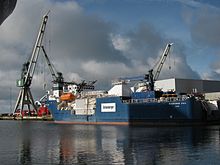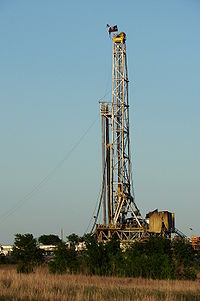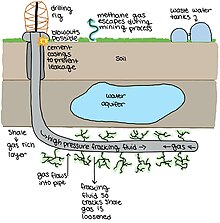| This article needs additional citations for verification. Please help improve this article by adding citations to reliable sources. Unsourced material may be challenged and removed. Find sources: "Well stimulation" – news · newspapers · books · scholar · JSTOR (June 2012) (Learn how and when to remove this message) |

Well stimulation is a broad term used to describe the various techniques and well interventions that can be used to restore or enhance the production of hydrocarbons from an oil well.
Hydraulic fracturing (fracking) and acidizing are two of the most common methods for well stimulation. These well stimulation techniques help create pathways for oil or gas to flow more easily, ultimately increasing the overall production of the well.
Well stimulation can be performed on an oil or gas well located onshore or offshore.
Cleaning the formation
The assortment of drilling fluid pumped down the well during drilling and completion can often cause damage to the surrounding formation by entering the reservoir rock and blocking the pore throats (the channels in the rock throughout which the reservoir fluids flow). Similarly, the act of perforating can have a similar effect by jetting debris into the perforation channels. Both these situations reduce the permeability in the near well bore area and so reduce the flow of fluids into the well bore.
A simple and safe solution is to pump diluted acid mixtures from surface into the well to dissolve the offending material. Once dissolved, permeability should be restored and the reservoir fluids will flow into the well bore, cleaning up what is left of the damaging material. After initial completion, it is common to use minimal amounts of formic acid to clean up any mud and skin damage. In this situation, the process is loosely referred to as "well stimulation." Oftentimes, groups that oppose oil and gas production refer to the process as "acidization," which is actually the use of acids in high volume and high pressure to stimulate oil production.
In more serious cases, pumping from surface is insufficient as it does not target any particular location downhole and reduces the chances of the chemical retaining its effectiveness when it gets there. In these cases, it is necessary to spot the chemical directly at its target through the use of coiled tubing. Coiled tubing is run in hole with a jetting tool on the end. When the tool is at its target, the chemical is pumping through the pipe and is jetted directly onto the damaged area. This can be more effective than pumping from surface, though it is much more expensive, and accuracy is dependent on knowing the location of the damage.
Extending the perforation tunnels and fractures
| This section needs additional citations for verification. Please help improve this article by adding citations to reliable sources in this section. Unsourced material may be challenged and removed. (July 2024) (Learn how and when to remove this message) |
In cased hole completions, perforations are intended to create a hole through the steel casing so that the reservoir can be produced. The holes are typically formed by shaped explosives that perforate the casing and create a fractured hole into the reservoir rock for a short distance. In many cases, the tunnels created by the perforation guns do not provide enough surface area and it becomes desirable to create more area in contact with the wellbore.
In some cases, more area is needed if the reservoir is of low permeability. In other cases, damage caused by drilling and completion operations can be severe enough that the perforation tunnel does not effectively penetrate through the damaged volume near the bore. This means that the ability of fluids to flow into the existing perforation tunnels is too limited. One method to achieve more stimulation is by carrying out a hydraulic fracture treatment through the perforations.
If permeability is naturally low, then as fluid is drained from the immediate area, replacement fluid may not flow into the void sufficiently quickly to make up for the voidage and so the pressure drops. The well cannot then flow at a rate sufficient to make production economic. In this case, extending a hydraulic fracture deeper into the reservoir will allow higher production rates to be achieved.
Propellant stimulations can be a very economical way to clean up nearbore damage. Propellants are a low-explosive material that generate large amounts of gas downhole very rapidly. The gas pressure builds in the wellbore, increasing tension in the rock until it becomes greater than the breakdown pressure of the formation. Fracture length and fracture pattern are highly dependent on the type of propellant stimulation tool that is used.
Acidization
Acidizing is a well stimulation technique that injects an acid solution into the well. Acidization process cleans out debris clogging the well and increases the permeability of the reservoir rock, allowing oil or gas to flow more freely.
Hydraulic fracturing
This section is an excerpt from Fracking.| Fracking |
|---|
 |
| By country |
| Environmental impact |
| Regulation |
| Technology |
| Politics |
Hydraulic fracturing is a well stimulation technique involving the fracturing of formations in bedrock by a pressurized liquid. The process involves the high-pressure injection of "fracking fluid" (primarily water, containing sand or other proppants suspended with the aid of thickening agents) into a wellbore to create cracks in the deep rock formations through which natural gas, petroleum, and brine will flow more freely. When the hydraulic pressure is removed from the well, small grains of hydraulic fracturing proppants (either sand or aluminium oxide) hold the fractures open.
Hydraulic fracturing began as an experiment in 1947, and the first commercially successful application followed in 1949. As of 2012, 2.5 million "frac jobs" had been performed worldwide on oil and gas wells, over one million of those within the U.S. Such treatment is generally necessary to achieve adequate flow rates in shale gas, tight gas, tight oil, and coal seam gas wells. Some hydraulic fractures can form naturally in certain veins or dikes. Drilling and hydraulic fracturing have made the United States a major crude oil exporter as of 2019, but leakage of methane, a potent greenhouse gas, has dramatically increased. Increased oil and gas production from the decade-long fracking boom has led to lower prices for consumers, with near-record lows of the share of household income going to energy expenditures.
Hydraulic fracturing is highly controversial. Its proponents highlight the economic benefits of more extensively accessible hydrocarbons (such as petroleum and natural gas), the benefits of replacing coal with natural gas, which burns more cleanly and emits less carbon dioxide (CO2), and the benefits of energy independence. Opponents of fracking argue that these are outweighed by the environmental impacts, which include groundwater and surface water contamination, noise and air pollution, the triggering of earthquakes, and the resulting hazards to public health and the environment. Research has found adverse health effects in populations living near hydraulic fracturing sites, including confirmation of chemical, physical, and psychosocial hazards such as pregnancy and birth outcomes, migraine headaches, chronic rhinosinusitis, severe fatigue, asthma exacerbations and psychological stress. Adherence to regulation and safety procedures are required to avoid further negative impacts.
The scale of methane leakage associated with hydraulic fracturing is uncertain, and there is some evidence that leakage may cancel out any greenhouse gas emissions benefit of natural gas relative to other fossil fuels.

Lifting the well
Some stimulation techniques do not necessarily mean altering the permeability outside the well bore. Sometimes they involve making it easier for fluids to flow up the well bore having already entered. Gas lift is sometimes considered a form of stimulation, particularly when it is only used for starting up the well and shut off during steady state operation. More commonly though, lifting as a stimulation refers to trying to lift out heavy liquids that have accumulated at the bottom, either through water entry from the formation or through chemicals injected from surface such as scale inhibitors and methanol (hydrate inhibitor). These liquids sit at the bottom of the well as can act as a weight holding back the flow of reservoir fluids, essentially acting to kill the well. They can be removed by circulating nitrogen using coiled tubing.
Well stimulation vessels
In more recent times, due to the temporary nature of well stimulation, specialized drilling ships known as "well stimulation vessels" have been used for deep sea well stimulation. Offshore companies such as Norshore and Schlumberger operate a fleet of such specialized ships. Also known as "Multipurpose drilling vessels", these ships replace the conventional drilling oil rig, thus resulting in considerable savings in cost. Some WSV's such as the "Norshore Atlantic" are able to perform multiple tasks including riserless operation in the shallow- and mid-water segments, drilling complete oil wells and performing complete subsea decommissioning (P&A). They are also able to perform pre-drilling of the top hole sections in deep water and well intervention operations with workover risers.
See also
Notes
- Also known as hydraulic fracturing, fracing, hydrofracturing, or hydrofracking.
References
- Nolan, Dennis P. (2019), "Overview of Oil, Gas, and Petrochemical Facilities", Handbook of Fire and Explosion Protection Engineering Principles for Oil, Gas, Chemical, and Related Facilities, Elsevier, pp. 33–50, doi:10.1016/B978-0-12-816002-2.00002-7, ISBN 978-0-12-816002-2, retrieved 2024-10-17
- "How Does Well Acidizing Work to Stimulate Production?". www.rigzone.com. Retrieved 2020-06-30.
- Leong, Van Hong; Ben Mahmud, Hisham (2019-03-01). "A preliminary screening and characterization of suitable acids for sandstone matrix acidizing technique: a comprehensive review". Journal of Petroleum Exploration and Production Technology. 9 (1): 753–778. Bibcode:2019JPEPT...9..753L. doi:10.1007/s13202-018-0496-6. hdl:20.500.11937/71306. ISSN 2190-0566.
- "Acidizing Oil and Natural Gas Briefing Paper" (PDF). American Petroleum Institute. October 18, 2024. Retrieved October 18, 2024.
- Gandossi, Luca; Von Estorff, Ulrik (2015). An overview of hydraulic fracturing and other formation stimulation technologies for shale gas production – Update 2015 (PDF). Scientific and Technical Research Reports (Report). Joint Research Centre of the European Commission; Publications Office of the European Union. doi:10.2790/379646. ISBN 978-92-79-53894-0. ISSN 1831-9424. Retrieved 31 May 2016.
- Suchy, Daniel R.; Newell, K.David (15 May 2012). "Kansas Geological Survey, Public Information Circular (PIC) 32". Kansas Geological Survey. Retrieved 8 October 2021.
- King, George E (2012), Hydraulic fracturing 101 (PDF), Society of Petroleum Engineers, SPE 152596 – via Kansas Geological Survey
- "State by state maps of hydraulic fracturing in US". Fractracker.org. Retrieved 19 October 2013.
- Charlez, Philippe A. (1997). Rock Mechanics: Petroleum Applications. Paris: Editions Technip. p. 239. ISBN 978-2-7108-0586-1. Retrieved 14 May 2012.
- Blundell D. (November 2005). "Processes of tectonism, magmatism and mineralization: Lessons from Europe". Ore Geology Reviews. 27 (1–4: Special Issue: Geodynamics and Ore Deposit Evolution in Europe): 340. doi:10.1016/j.oregeorev.2005.07.003. ISBN 978-0-444-52233-7.
{{cite journal}}: CS1 maint: year (link) - Clifford Krauss (3 February 2019). "The 'Monster' Texas Oil Field That Made the U.S. a Star in the World Market". The New York Times. Retrieved 21 September 2019.
The shale-drilling frenzy in the Permian has enabled the United States not only to reduce crude-oil imports, but even to become a major exporter New technologies for drilling and hydraulics fracturing helped bring the break-even price
- Umair Irfan (13 September 2019). "The best case for and against a fracking ban". Vox. Retrieved 21 September 2019.
During much of the fracking boom, the US economy grew and emissions declined. One study found that between 2005 and 2012, fracking created 725,000 jobs. That's largely due to natural gas from fracking displacing coal in electricity production.
- "Fracking fluid is leaking more often than we thought possible". Popular Science. 24 February 2017. Retrieved 22 September 2022.
- Rebecca Elliott; Luis Santiago (17 December 2019). "A Decade in Which Fracking Rocked the Oil World". The Wall Street Journal. Retrieved 20 December 2019.
... hydraulic fracturing techniques spurred a historic U.S. production boom during the decade that has driven down consumer prices, buoyed the national economy and reshaped geopolitics.
- "2019 Sustainable Energy in America Factbook" (PDF). Bloomberg New Energy Finance. Retrieved 28 April 2020.
- Urbina, Ian. "Drilling Down". The New York Times.
- IEA (29 May 2012). Golden Rules for a Golden Age of Gas. World Energy Outlook Special Report on Unconventional Gas (PDF). OECD. pp. 18–27.
- Hillard Huntington et al. EMF 26: Changing the Game? Emissions and Market Implications of New Natural Gas Supplies Archived 30 November 2020 at the Wayback Machine Report. Stanford University. Energy Modeling Forum, 2013.
- "What is fracking and why is it controversial?". BBC News. 15 October 2018.
- "Cost and performance baseline for fossil energy plants, Volume 1: Bituminous coal and natural gas to electricity" (PDF). National Energy Technology Laboratory (NETL), United States Department of Energy. November 2010. Archived from the original (PDF) on 24 January 2014. Retrieved 15 August 2019.
- "The Fracking Industry Deserves Our Gratitude". National Review. 5 July 2017. Retrieved 26 October 2022.
- Fischetti, Mark (20 August 2013). "Groundwater Contamination May End the Gas-Fracking Boom". Scientific American. Vol. 309, no. 3.
- Brown, Valerie J. (February 2007). "Industry Issues: Putting the Heat on Gas". Environmental Health Perspectives. 115 (2): A76. doi:10.1289/ehp.115-a76. PMC 1817691. PMID 17384744.
- V. J. Brown (February 2014). "Radionuclides in Fracking Wastewater: Managing a Toxic Blend". Environmental Health Perspectives. 122 (2): A50 – A55. doi:10.1289/ehp.122-A50. PMC 3915249. PMID 24486733.
- Bamber, AM; Hasanali, SH; Nair, AS; Watkins, SM; Vigil, DI; Van Dyke, M; McMullin, TS; Richardson, K (15 June 2019). "A Systematic Review of the Epidemiologic Literature Assessing Health Outcomes in Populations Living near Oil and Natural Gas Operations: Study Quality and Future Recommendations". International Journal of Environmental Research and Public Health. 16 (12): 2123. doi:10.3390/ijerph16122123. PMC 6616936. PMID 31208070.
- Wright, R; Muma, RD (May 2018). "High-Volume Hydraulic Fracturing and Human Health Outcomes: A Scoping Review". Journal of Occupational and Environmental Medicine. 60 (5): 424–429. doi:10.1097/JOM.0000000000001278. PMID 29370009. S2CID 13653132. Retrieved 25 November 2019.
- Gorski, Irena; Schwartz, Brian S. (25 February 2019). "Environmental Health Concerns From Unconventional Natural Gas Development". Oxford Research Encyclopedia of Global Public Health. doi:10.1093/acrefore/9780190632366.013.44. ISBN 978-0-19-063236-6. Retrieved 20 February 2020.
- Costa, D; Jesus, J; Branco, D; Danko, A; Fiúza, A (June 2017). "Extensive review of shale gas environmental impacts from scientific literature (2010-2015)". Environmental Science and Pollution Research International. 24 (17): 14579–14594. Bibcode:2017ESPR...2414579C. doi:10.1007/s11356-017-8970-0. PMID 28452035. S2CID 36554832.
- Storrow, Benjamin (2020-05-05). "Methane Leaks Erase Some of the Climate Benefits of Natural Gas". Scientific American. Retrieved 2023-09-12.
- Zhang, Yuzhong; Gautam, Ritesh; Pandey, Sudhanshu (2020-04-23). "Quantifying methane emissions from the largest oil producing basin in the U.S. from space - Methane Emissions from the Permian Basin" (PDF). Science Advances.
- Kim, Won-Young 'Induced seismicity associated with fluid injection into a deep well in Youngstown, Ohio', Journal of Geophysical Research-Solid Earth
- US Geological Survey, Produced water, overview, accessed 8 November 2014.
- Jared Metzker (7 August 2013). "Govt, Energy Industry Accused of Suppressing Fracking Dangers". Inter Press Service. Retrieved 28 December 2013.
- Patel, Tara (31 March 2011). "The French Public Says No to 'Le Fracking'". Bloomberg Businessweek. Archived from the original on 4 April 2011. Retrieved 22 February 2012.
- Patel, Tara (4 October 2011). "France to Keep Fracking Ban to Protect Environment, Sarkozy Says". Bloomberg Businessweek. Archived from the original on 8 October 2011. Retrieved 22 February 2012.
- "Commission recommendation on minimum principles for the exploration and production of hydrocarbons (such as shale gas) using high-volume hydraulic fracturing (2014/70/EU)". Official Journal of the European Union. 22 January 2014. Retrieved 13 March 2014.
- "Marine well stimulation vessels growing larger, more efficient". www.offshore-mag.com. 1 Jun 2000. Retrieved 2020-06-30.
- "Stim vessel survey reflects changing market conditions". www.offshore-mag.com. 1 July 2019. Retrieved 2020-06-30.
- "Types of offshore operating units". www.norshore.com. Norshore. Retrieved 25 September 2017.
- "Norshore marine names "Norshore Atlantic" at Batam shipyard". Offshore energy today. 28 February 2014. Retrieved 25 September 2017.
- "Specifications of the Norshore Atlantic" (PDF). www.norshore.com. Norshore. Retrieved 25 September 2017.
- "About well simulation vessels". www.bakerhughes.com. Baker Hughes. Retrieved 25 September 2017.